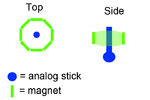John Ingato
Newbie level 4
Hello internet strangers,
I was hoping to get some advice from some electronics experts. I am a software engineer with a background in C/C++ but electromagnets are new to me. Here's what I am trying to accomplish. I was hoping to get some advice on how I can achieve this and where to start to learn how.
My goal is to be able to have a set of electromagnets that I can control with computer software. I would like to be able to turn them on / off and also have a variable strength that I can adjust. I also need to be able to flip the polarity of the electromagnet at any given time. I was thinking I could use an Arduino or Raspberry Pi for the hardware, but I'm not sure what else I would need. I would obviously need an external battery for the power source and the breakout board to connect to the magnets to. I've read online of people using light dimmers to adjust the strength, but I want to be able to do that with software, from my computer.
Is this something that could be done pretty easily? I could do all the programming Im sure. I just need to understand the hardware and electromagnetic properties. I'd also like to use very small electromagnets, under a half inch in diameter at least, but I can't seem to find any that small? If you could suggest a good site to buy the hardware that would be awesome.
Thanks!
-J
I was hoping to get some advice from some electronics experts. I am a software engineer with a background in C/C++ but electromagnets are new to me. Here's what I am trying to accomplish. I was hoping to get some advice on how I can achieve this and where to start to learn how.
My goal is to be able to have a set of electromagnets that I can control with computer software. I would like to be able to turn them on / off and also have a variable strength that I can adjust. I also need to be able to flip the polarity of the electromagnet at any given time. I was thinking I could use an Arduino or Raspberry Pi for the hardware, but I'm not sure what else I would need. I would obviously need an external battery for the power source and the breakout board to connect to the magnets to. I've read online of people using light dimmers to adjust the strength, but I want to be able to do that with software, from my computer.
Is this something that could be done pretty easily? I could do all the programming Im sure. I just need to understand the hardware and electromagnetic properties. I'd also like to use very small electromagnets, under a half inch in diameter at least, but I can't seem to find any that small? If you could suggest a good site to buy the hardware that would be awesome.
Thanks!
-J

